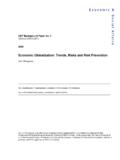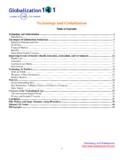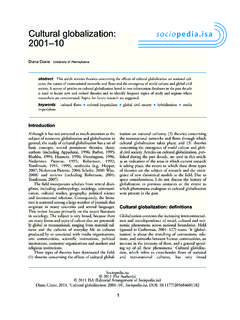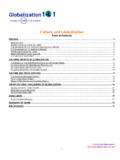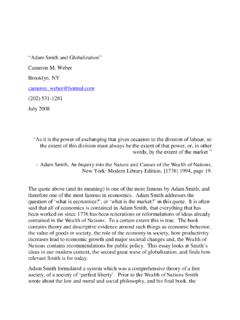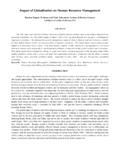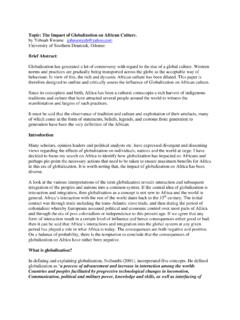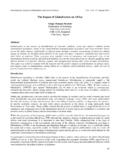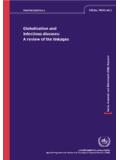Transcription of Benefits and Risks of Financial Globalization: …
1 Benefits and Risks of Financial globalization : Challenges for Developing Countries Sergio L. Schmukler* Senior Economist Development Research Group World Bank June 2004 Abstract This paper discusses the Benefits and Risks that Financial globalization entails for developing countries. Financial globalization can lead to large Benefits , particularly to the development of the Financial system. But Financial globalization can also come with crises and contagion. The net effect of Financial globalization is likely positive in the long run, with Risks being more prevalent right after countries liberalize.
2 So far, only some countries, sectors, and firms have taken advantage of globalization . As Financial systems turn global, governments lose policy instruments, so there is an increasing scope for some form of international Financial policy cooperation. Keywords: Financial globalization , Financial liberalization, international Financial markets, crises JEL classification codes: F02, F21, F30, F33, F35, F42, G15, G28 * This paper is partly based on the background paper prepared for the World Bank Policy Research Report globalization , Growth, and Poverty, available at David Dollar, Chang-Tai Hsieh, Rick Mishkin, and Jose Antonio Ocampo, among others, provided several helpful comments on earlier versions of this work.
3 I thank Pablo Zoido-Lobaton for letting me use some of the material on which we had worked together. I also thank Juan Carlos Gozzi Valdez and Marina Halac, who provided excellent research assistance. A related version of this paper will be published at the Atlanta Fed Economic Review. The findings, interpretations, and conclusions expressed in this paper are entirely those of the author; they do not necessarily represent the views of the World Bank. Email address: 1 1.
4 Introduction The recent wave of globalization has generated an intense debate among economists, attracting both strong supporters and opponents. This paper outlines the Benefits and Risks that Financial globalization entails for developing countries. The paper revisits the arguments and evidence that can be used in favor and against globalization , as well as the policy options. In this paper, Financial globalization is understood as the integration of a country s local Financial system with international Financial markets and institutions.
5 This integration typically requires that governments liberalize the domestic Financial sector and the capital account. Integration takes place when liberalized economies experience an increase in cross-country capital movement, including an active participation of local borrowers and lenders in international markets and a widespread use of international Financial intermediaries. Although developed countries are the most active participants in the Financial globalization process, developing countries (primarily middle-income countries) have also started to participate.
6 This paper focuses on the integration of developing countries with the international Financial From a historical perspective, Financial globalization is not a new phenomenon, but today s depth and breath are Capital flows have existed for a long time. In fact, according to some measures, the extent of capital mobility and capital flows a hundred years ago is comparable to today s. At that time, however, only few countries and sectors participated in Financial globalization .
7 Capital flows tended to follow migration and were generally directed towards supporting trade flows. For the most part, capital flows took the form of bonds and they were of a long-term nature. International investment was dominated by a small number of freestanding companies, and Financial intermediation was concentrated on a few family groups. The international system was dominated by the gold standard, according to which gold backed national currencies.
8 The advent of the First World War represented the first blow to this wave of Financial globalization , which was followed by a period of instability and crises ultimately leading to the Great Depression and the Second World War. After these events, governments reversed Financial globalization imposing capital controls to regain monetary policy autonomy. Capital flows reached an all time low during the 1950s and 1960s. The international system was dominated by the Bretton Woods system of fixed but adjustable exchange rates, limited capital mobility, and autonomous monetary policies.
9 As Mundell (2000) argues, the 1970s witnessed the beginning of a new era in the international Financial system. As a result of the oil shock and the breakup of the Bretton 1 In this paper, developing countries are all low- and middle-income countries as defined by the World Bank. Emerging markets are middle-income developing countries. 2 Several authors analyze different measures of Financial globalization , arguing that there were periods of high Financial globalization in the past.
10 For a review of this literature see Baldwin and Martin (1999). 2 Woods system, a new wave of globalization began. The oil shock provided international banks with fresh funds to invest in developing countries. These funds were used mainly to finance public debt in the form of syndicated loans. With the disintegration of the Bretton Woods system of fixed exchange rates, countries were able to open up to greater capital mobility while keeping the autonomy of their monetary policies.










